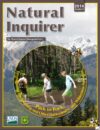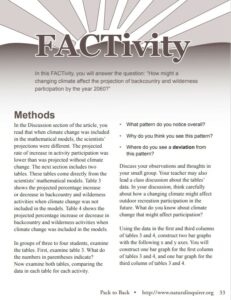Pack to Back: Investigating Backpacking and Other Backcountry and Wilderness Activities

The scientists in this study wanted to answer two questions: (1) How many people in the United States are projected to participate in four backcountry and wilderness activities in 2060 compared with participation in 2008? (2) On average, how many days per year is each person projected to participate in 2060 compared with the number of days per year in 2008?

-
 In this FACTivity, you will answer the question: “How might a changing climate affect the projection of backcountry and wilderness participation by the year 2060?” You will answer this question...
In this FACTivity, you will answer the question: “How might a changing climate affect the projection of backcountry and wilderness participation by the year 2060?” You will answer this question...FACTivity – Pack to Back
In this FACTivity, you will answer the question: “How might a changing climate affect the projection of backcountry and wilderness participation by the year 2060?” You will answer this question... -
 The question you will answer in this FACTivity is, “Should forest managers allow mountain biking in potential wilderness areas?” To answer this question, you will read background information about the...
The question you will answer in this FACTivity is, “Should forest managers allow mountain biking in potential wilderness areas?” To answer this question, you will read background information about the...Alternate FACTivity – Pack to Back
The question you will answer in this FACTivity is, “Should forest managers allow mountain biking in potential wilderness areas?” To answer this question, you will read background information about the...
-
 The idea of protecting lands as wilderness did not happen overnight. Before the National Wilderness Preservation System was established in 1964, many people took actions that helped Americans understand the...
The idea of protecting lands as wilderness did not happen overnight. Before the National Wilderness Preservation System was established in 1964, many people took actions that helped Americans understand the...Spotlight – Wilderness Act Timeline (Pack to Back)
The idea of protecting lands as wilderness did not happen overnight. Before the National Wilderness Preservation System was established in 1964, many people took actions that helped Americans understand the...
Glossary
View All Glossary-

Ken Cordell
“I like my work and working for the Forest Service very much. My work as a scientist involves studying how people relate to the natural world and what they like..."> View Profile -

Michael Bowker
One of the great joys I receive from being a scientist has been seeing both of my children pursue science degrees in college. My favorite science experience was working on..."> View Profile
Standards addressed in this Article:
Social Studies Standards
- Civic Ideals and Practices
- Culture
- Global Connections
- Individuals, Groups, and Institutions
- People, Places, and Environments
- Power, Authority, and Governance
- Production, Distribution, and Consumption
- Time, Continuity, and Change
Note To Educators
The Forest Service's Mission
The Forest Service’s mission is to sustain the health, diversity, and productivity of the Nation’s forests and grasslands to meet the needs of present and future generations. For more than 100 years, our motto has been “caring for the land and serving people.” The Forest Service, an agency of the U.S. Department of Agriculture (USDA), recognizes its responsibility to be engaged in efforts to connect youth to nature and to promote the development of science-based conservation education programs and materials nationwide.

What Is the Natural Inquirer?
Natural Inquirer is a science education resource journal to be used by students in grade 6 and up. Natural Inquirer contains articles describing environmental and natural resource research conducted by Forest Service scientists and their cooperators. These scientific journal articles have been reformatted to meet the needs of middle school students. The articles are easy to understand, are aesthetically pleasing to the eye, contain glossaries, and include hands-on activities. The goal of Natural Inquirer is to stimulate critical reading and thinking about scientific inquiry and investigation while teaching about ecology, the natural environment, and natural resources.

-
Meet the Scientists
Introduces students to the scientists who did the research. This section may be used in a discussion about careers in science.
-
What Kinds of Scientist Did This Research?
Introduces students to the scientific disciplines of the scientists who conducted the research.
-
Thinking About Science
Introduces something new about the scientific process, such as a scientific habit of mind or procedures used in scientific studies.
-
Thinking About the Environment
Introduces the environmental topic being addressed in the research.
-
Introduction
Introduces the problem or question that the research addresses.
-
Method
Describes the method the scientists used to collect and analyze their data.
-
Findings & Discussion
Describes the results of the analysis. Addresses the findings and places them into the context of the original problem or question.
-
Reflection Section
Presents questions aimed at stimulating critical thinking about what has been read or predicting what might be presented in the next section. These questions are placed at the end of each of the main article sections.
-
Number Crunches
Presents an easy math problem related to the research.
-
Glossary
Defines potentially new scientific or other terms to students. The first occurrence of a glossary word is bold in the text.
-
Citation
Gives the original article citation with an internet link to the original article.
-
FACTivity
Presents a hands-on activity that emphasizes something presented in the article.
Science Education Standards
You will find a listing of education standards which are addressed by each article at the back of each publication and on our website.
We Welcome Feedback
-
Contact
Jessica Nickelsen
Forest Service -
Email
Lessons
-
 This lesson plan helps students explore how wilderness has been supported (or not supported) by politicians over United States history.
This lesson plan helps students explore how wilderness has been supported (or not supported) by politicians over United States history.Lesson Plan – Wilderness 50
This lesson plan helps students explore how wilderness has been supported (or not supported) by politicians over United States history.
Education Files
Project Learning Tree
If you are a Project Learning Tree trained educator, you may also use
the following activity as an added resource: “School Yard Safari.”






